In a year that has seen quarantines, illness and death, closures and business collapses, Chabad worldwide is preparing the largest Chanukah awareness campaign in history.
By Dovid Margolin – Chabad.org
One night in early November, Vienna exploded with the sharp cracks of automatic gunfire. An Islamist terrorist had struck the Austrian capital. By the time police neutralized him, he had murdered four and injured 23, leaving the cobblestone streets of old Vienna stained with blood.
The gunman had marked all Austrians as potential victims, killing indiscriminately, yet his rampage began outside the city’s Stadttempel, the only Viennese synagogue to survive Kristallnacht and Nazi rule. Even though the synagogue and adjacent offices were shuttered at the time, the attack harkened back grimly to the 1981 Vienna synagogue shooting, when terrorists killed two and injured 30 on the same spot.
“It was terrifying,” says Eliyahu Medvinskyy, a 34-year-old husband and father in the Vienna Jewish community. “It broke 40 years of peace here.”
It didn’t help that the surprise attack came the night before Austria was set to enter a second coronavirus lockdown, further clouding an already dark year. All of this, says Rabbi Mottel Segal, co-director of Chabad-Lubavitch House in Vienna’s Second District, underscores the vital importance of the impending holiday of Chanukah, which begins this year on Thursday evening, Dec. 10, and runs through Friday, Dec. 18.
“It’s not just about making sure we can celebrate Chanukah as usual,” explains Segal. “People here are shocked, afraid. We saw darkness. Now we need to light up Vienna with the light of the Chanukah menorah as never before for the Jews of Austria and for all of its people.”
The heightened sense of urgency to share the message, spirit and hope of Chanukah like never before is not unique to Vienna. In a year that has seen quarantines, illness and death, closures and business collapses, all amid an overwhelming sense of sheer confusion and even despair, the Chabad-Lubavitch movement worldwide is preparing the largest Hanukkah awareness campaign in history.
This year’s efforts will see Chabad erect some 15,000 large public menorahs around the world with an additional 6,500 menorah-topped cars hitting the streets. Chabad emissaries are distributing 64 million Hanukkah candles and 700,000 menorah kits to anyone in need; and handing out some 2.5 million holiday guides in 17 languages. With so many people isolating at home, this year Chabad will also be shipping or delivering an estimated 350,000 Hanukkah-at-home kits to young people, families and the elderly. At the same time, the Ambassadors of Light program enlists people of all ages around the world to share Hanukkah with those around them, providing them with everything they need to assist friends, family and co-workers to celebrate the Festival of Lights. All told, the campaign is expected to reach 8 million Jews in more than 100 countries.
With at-home celebrations at least temporarily replacing larger gatherings and increased demand for online assistance, the Judaism website Chabad.org is also expecting a significant jump to the annual 7 million unique visitors who come to Hanukkah.org. Among the new offerings is 12 Tips for an Amazing Hanukkah at Home, which smoothly guides anyone, anywhere, through all of the Hanukkah essentials.
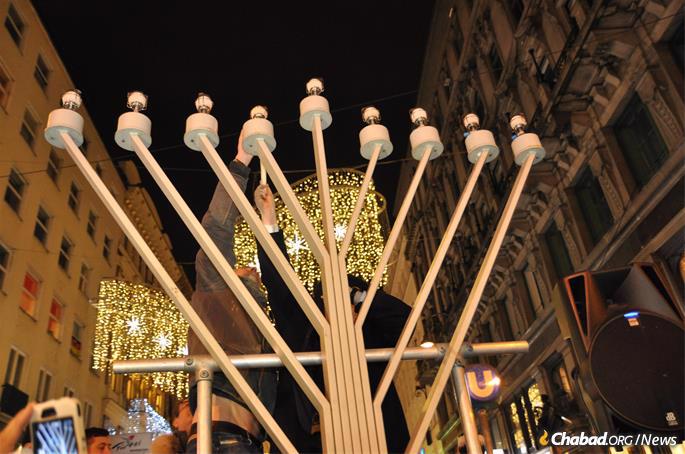
The effort stems directly from the Rebbe who revitalized the modern observance of Hanukkah when he launched his Hanukkah awareness campaign in 1973.
“There is a preeminence in the [mitzvot] connected with lighting candles … in that the effect of the action, the appearance of light, is immediately visible … ,” the Rebbeexplained in his public letter for Hanukkah 1973. “[T]he mitzvah of kindling the Hanukkah light is unique in that it is required to be displayed to the outside … . Thus every by-passer, including non-Jews, immediately notices the effect of the light, which illuminates the outside and the environment.”
The Rebbe called not only for every Jewish home to be filled with the light of the menorah, but that its flames illuminate the wider world as well. For Hanukkah in 1974, a Chabad emissary erected the very first public menorah outside of Independence Hall in Philadelphia, followed the next year by a 25-foot mahogany menorah raised in Union Square, San Francisco. By the end of the decade, Chabad emissaries were placing public menorahs on Fifth Avenue in New York City, outside the White House in Washington, D.C., and on the star-studded streets of Los Angeles, adding more cities every year. At the same time, Chabad activists hit the streets to distribute tin menorah and candle kits, giving them out as fast as they could manufacture them. These efforts, along with innovative programs, from Hanukkah on Ice to olive-oil press workshops, permanently transformed the breadth and depth of Hanukkah observance in the United States and around the world.
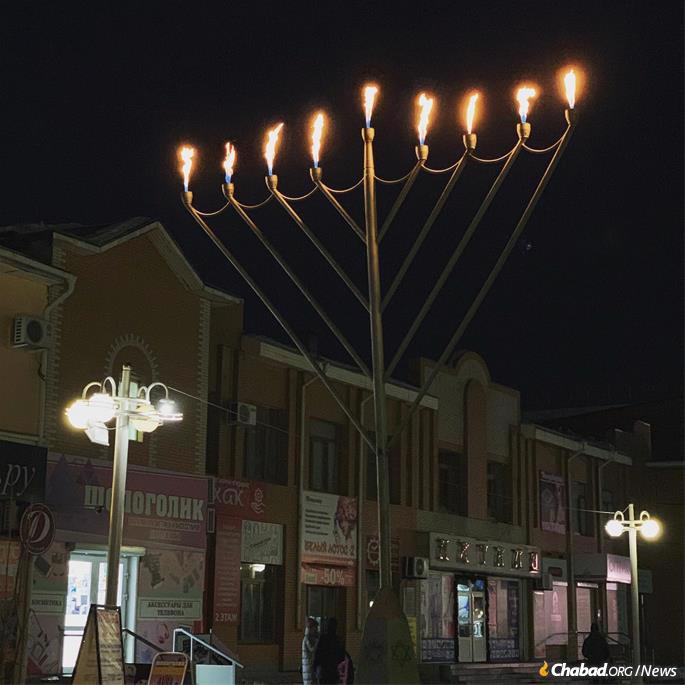
Lighting a Candle in Terror-Stricken Vienna
Chabad of Austria was founded by Rabbi Jacob and Edla Biderman in 1980, and in the years since has grown to encompass 30 emissary couples serving nine centers—one in Salzburg—and a vast educational network, including seven preschools, a Jewish day school and the Lauder Business School. Even as it remains unknown how long Austria’s coronavirus lockdown will last, the emissaries have barreled ahead with their Hanukkah preparations, planning COVID-appropriate celebrations for as many people as they can reach.
Chabad of Vienna’s large public menorah in the city center is going up again. They are planning a 50-menorah-topped-car Hanukkah parade through city streets and renting a massive drive-in movie theater for a Hanukkah program and concert for thousands. They are also readying packages that include a menorah, candles, the blessings, a dreidel and some Hanukkah treats to reach every Jew in Vienna without a menorah. More importantly, Jewish community members are enlisting via Chabad Vienna’s website to take menorah and candle kits and distribute them to friends, coworkers and neighbors so that the Hanukkah effort can reach the widest circle possible.
“It’s something I try to do every year—reach out to friends, and bring them a menorah and candles if they don’t have them,” says Medvinskyy, who moved to Vienna from Ukraine 10 years ago to study at Chabad’s Lauder Business School. But this year feels somehow different—something he felt this past Rosh Hashanah as well, when rabbis and volunteers spread throughout the city to blow the shofar for everyone in isolation. “It was this depressing time, and suddenly you heard the shofar on the streets of Vienna. Hanukkah will be even more than that,” he says.
In fact, Chabad’s public menorah is erected in Stephansplatz, the popular pedestrian plaza at the geographic center of Vienna, mere steps away from this month’s terror attack. There, its flames will illuminate the surrounding darkness, signaling to one and all G‑d’s miraculous deliverance of a militarily weak but spiritually strong Jewish people 2,160 years ago, and the ultimate triumph of light over darkness and good over evil.
“We cannot fight darkness with sticks,” says Medvinskyy. “We need to light a candle.”
Menorah in Stalin’s Zion
The giant public menorah was a uniquely American innovation—indeed, San Francisco’s massive menorah was the brainchild of the local Chabad rabbi and Holocaust-survivor rock impresario Bill Graham—but the idea of bringing the light of Hanukkah to the outside was in no way new. There was a time when all Jews had kindled their menorahs outside their homes, but centuries of persecution had driven them indoors. Those days were now over, the Rebbe explained, and it was time to bring the shining message of the Hanukkah menorah back into the streets once and for all, not just because Jews were free of persecution in the United States, but because the menorah is a source of inspiration for all humankind.
“The Hanukkah Menorah, with its universal message, which is especially akin to the spirit of liberty and independence of this nation,” the Rebbe wrote in 1982, “has won a place not only in Jewish life, but also in the life of the American people.”
Like so many other American exports, the public menorah soon began springing up in places like London, Paris and Buenos Aires. Biderman put up Vienna’s first menorah in 1982. “No one had ever seen such a thing,” he recalls.
The menorah broke through the Iron Curtain in 1990, and then on an even larger scale the next year, when it was kindled in the heart of the Kremlin in Moscow, then still the Soviet Union. The Rebbe participated in those events via live satellite broadcast. Today, among the dozens of menorahs erected around Russia’s capital, the central candle-lighting takes place in Revolution Square, obscuring a massive granite statue of Karl Marx. By now, the Hanukkah awareness campaign in the former Soviet Union reaches far beyond the main population centers.

One such place is Birobidzhan, the almost mythical capital of the distant Jewish Autonomous Region, established by Joseph Stalin. It was desolate Birobidzhan, in the furthest reaches of Siberia, that the Communists offered the Jews as a homeland in 1928, and in the 1930s the despot dispatched Jewish writers and artists there to lionize the non-existent virtues of this frozen Soviet Zion. With no choice but to comply, the writers did just that, and at its height the Jewish Autonomous Region was home to just under 50,000 Jews.
The vast majority eventually left, but Jews have continued to live in Birobidzhan to this day, and each Hanukkah, they gather to watch the lighting of a giant menorah near the monument to the Yiddish poet Sholom Aleichem. But it wasn’t always that simple.
“I grew up here during a time when anti-Semitism was at its height,” explains Rachmiel Leder, 78, whose parents moved to Birobidzhan in the early 1930s. The intense anti-Semitism stoked by Stalin in the post-war era meant that even Yiddish—ostensibly the official language of the Jewish Autonomous Region—was forced underground. “In 1949, they closed the Jewish Yiddish theater, the school where my sisters had gone, and the synagogue. If my parents spoke Yiddish, it was quietly, among themselves.”
That’s why Leder never formally learned the language. But he did learn enough to communicate with his elderly grandmother, who had come over from Ukraine to live with her children and spoke no Russian. Leder’s parents knew nothing about Judaism—“we were a Soviet family”—and so it was only through his grandmother that he was able to witness the age-old rituals of the Jewish people.
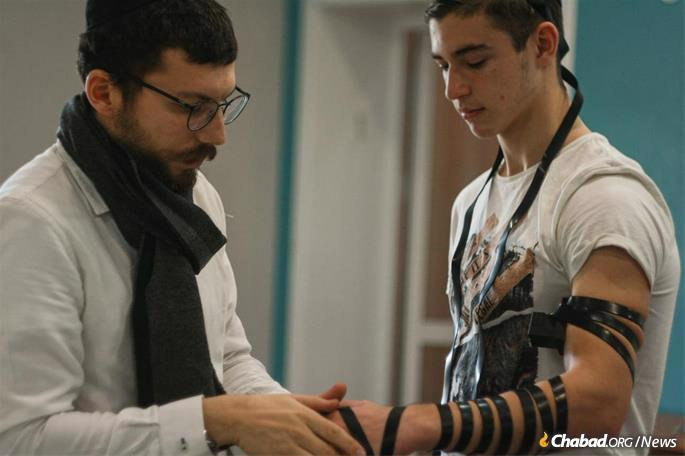
“My grandmother was observant,” Leder says, recalling the matzah she baked before Passover. “I was just a child. She’d tell us what she knew, but she herself was unlettered, so she did not know much.”
Come winter, she’d somehow ascertain the dates of Hanukkah—Leder assumes she got it in the small, illegal synagogue—and every evening lit a candle in her room, adding an additional one each night.
With the memory of his grandmother’s Hanukkah lights never quite extinguished, Leder joined the Komsomol Communist Youth League and then the Communist Party, eventually climbing the ranks to regional party boss responsible for communal housing, a position he held for decades. Thirteen years ago, Leder got involved in local Jewish life—the Birobidzhan Jewish community is affiliated with the Federation of Jewish Communities of Russia—to assist with organizational aspects of the work, becoming president of the community. Since then he has rediscovered his heritage, and began studying Torah, donning tefillin and celebrating Jewish holidays—none bringing him and his family more joy than Hanukkah.
“It’s a big, beautiful holiday here,” says Leder. “We light a giant menorah in the city center, usually with the mayor or the governor of the region. It’s frosty outside, we have doughnuts, some l’chaim, Jewish songs. Everyone comes out to watch. It’s a warm feeling that stays with us for the rest of the year.”
This year will be the first where Birobidzhan’s Jews will be led by their newly appointed chief rabbi, Rabbi Efraim Kolpak, who, together with his wife, Ida, recently took over the reins of Chabad of Birobidzhan. With the global pandemic reaching this Far Eastern corner of the world as well, the young couple are working to nevertheless make this Hanukkah an unforgettable one. In addition to multiple COVID-safe Hanukkah events and the outdoor grand menorah-lighting, Kolpak has arranged for city buses to navigate the snowy streets with LED menorahs affixed to their sides.
“There needs to be a Hanukkah atmosphere in the whole Birobidzhan,” says the young rabbi. “This is, after all, the ‘second Jerusalem.’ ”
Eight Nights, Eight Sites
Across the Pacific Ocean and more than 5,000 miles away sits beautiful Kelowna, British Columbia, about a four-hour’s drive northeast of Vancouver. When Rabbi Shmuly and Fraidy Hecht first established Chabad of the Okanagan in Kelowna in 2011, Hanukkah was just a few months away. Despite the short amount of time, the rabbi managed to receive permission from the city to erect a menorah outside of city hall, where they were joined by the mayor.
“When it went up that first time, it made me proud,” says Dr. Steve Faigan, a Kelowna periodontist who has lived in the area for more than 20 years. “Sometimes, we can be conservative, careful not to be too visible. Shmuly came with this chutzpah and put up the menorah, and I thought, ‘this is a good thing.’ This is our heritage and we’re proud of it, not afraid.”
Faigan says Jewish life in the Okanagan region, which has an overall population of about 200,000, is very different from what he experienced growing up in Montreal, but is nevertheless vibrant. In a way, he says, it’s even more fulfilling than in a large Jewish center.
“When you’re in a big community that can sometimes lead to complacency,” says Faigan. “When I got involved with the Jewish community here, I realized I’m much more involved and introspective about what Judaism means to me, and feel much more connected to my religion than I did in Montreal.”
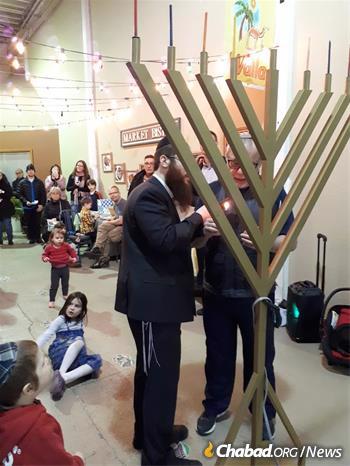
Kelowna is an affluent city and the region draws many for its quality of life, myriad forms of activity and mild weather, all within proximity to Vancouver. While far from isolated, the Okanagan Jewish community is a small one. Faigan says it’s all the more important to reach out to fellow Jews, “just to say, hey, we’re here,” while recognizing that everyone comes from varying backgrounds.
The Hechts have taken that to heart.
“In a way, the reality of COVID hasn’t changed things that much for us because we’ve always focused on those one-on-one relationships,” explains Rabbi Hecht.
Hanukkah is no different. Chabad of Okanagan’s Hanukkah programming is encapsulated in their “Eight Nights, Eight Sites” project. With one night set aside for a central celebration in Kelowna—this year, the program will be entirely outdoors—over the rest of Hanukkah, the Hecht family packs into a vehicle and heads out to places like Vernon and Salmon Arm to the north, and Summerland and Penticton in the south, bringing the spirit of Hanukkah with them. With no kosher bakery or store within 350 kilometers, Fraidy Hecht herself bakes the traditional doughnuts and fries the latkes they bring along.
This year’s celebrations Okanagan-wide will, of course, be mindful of COVID, but Hanukkah itself will remain unchanged, the menorah’s flames proclaiming that though the sun has set and darkness abounds, G‑d gives each individual a way to shine. It’s the reason, says Hecht, why Hanukkah resonates with so many.
“On Hanukkah, you see the world as it truly is,” he says. “We are not creating a new light; it’s what has been there all along. We just need to reveal it.”
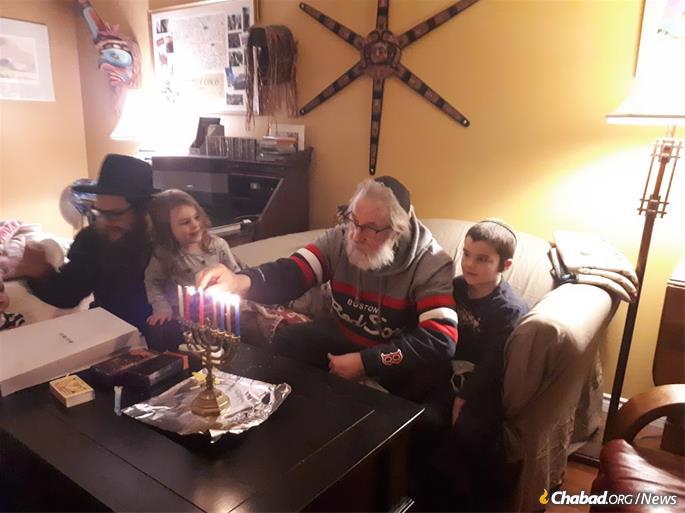
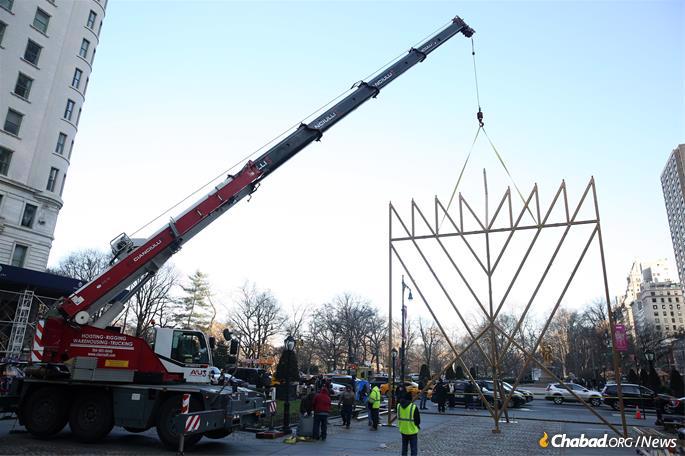
Reprinted with permission from Chabad.org
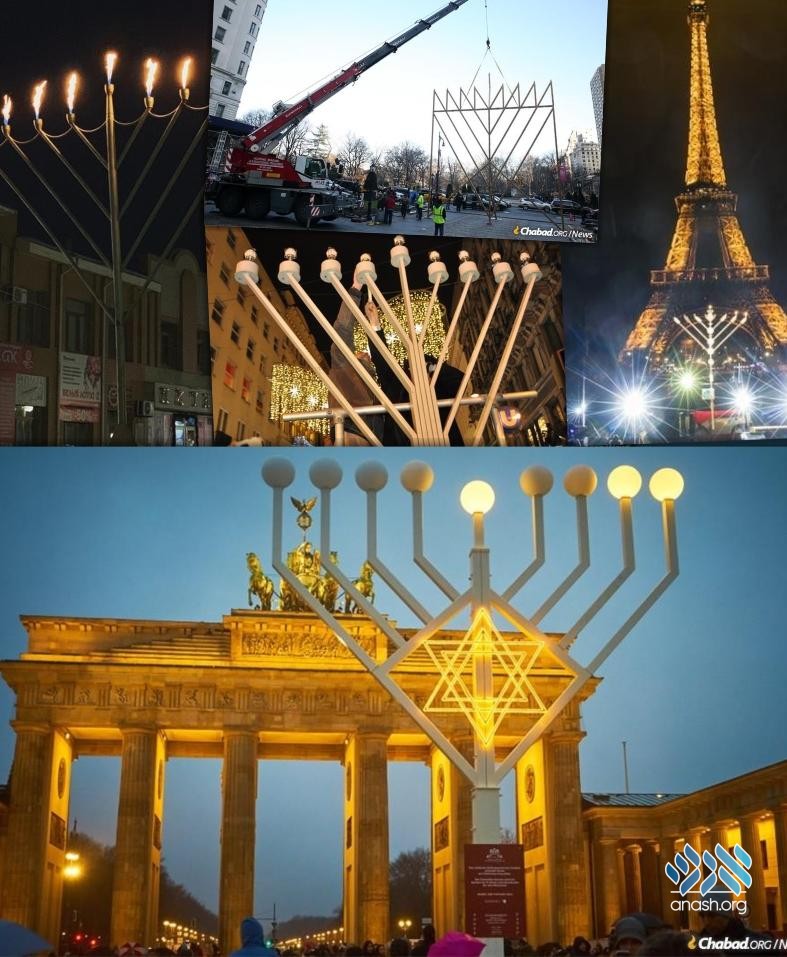
Discussion
We appreciate your feedback. If you have any additional information to contribute to this article, it will be added below.